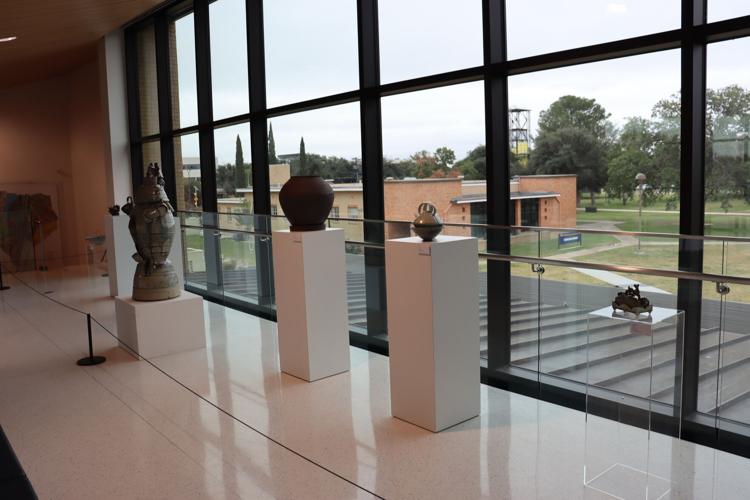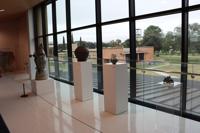Angelo State University's assistant professor of ceramics Hayun Surl's clay exhibit, “Recollection,” is on display in the Mayer Museum from 10 a.m. to 5 p.m. until Dec. 2, 2023.

Surl has been evolving his clay techniques, and his work reflects his life experiences and artistic development over time. His background as an interior designer has also influenced his work. He completed a two-year apprenticeship under a renowned ceramic artist in South Korea. He blends contemporary approaches to ceramics with traditional Eastern techniques.
Surl’s journey as a ceramics artist began with the concept of space. “If you look at the pottery, it has an interplay between the content and containment,” Surl said. “The vessel exists so that we can contain something in it – could be some food or water, any kinds of things.”
Surl’s specialty is interior design, and both interior design and pottery deal with spatial concepts. “So we as human beings, we're the content of the surrounding space, which is the architecture. So I've always been fascinated by this concept of the pottery, which is also a form of architecture, the space that I'm thinking about. So that is a starting point that I wanted to go deeper into this — just, utilitarian of functional pottery,” Surl said.
Surl advised students to first ask themselves the reason why they want to do pottery. “The pottery is the part of the art, right? And then you could think about the art, the artist of reflection of the society. You as a vehicle are a reflection of what you've been influenced by, the surrounding beings. It could be social, political, cultural, environmental,” Surl said.

When working with clay, Surl considered the board, clay and the limits of pottery. “So I guess you’re more limited to the pottery itself, it's more important to understand the clay as the material itself. What kind of clay can render that other material cannot do? Why does it have to be specifically the clay and then even more specifically, why does it have to be the pottery form?” Surl said.
“Pottery is really about the human interaction between the object and the user,” Surl said. People have grown used to using mass-produced and manufactured products from factories ever since the Second Industrial Revolution, so people often don’t know who made the products they use. Thus, people don’t have much attachment to the objects they use.
Using scissors as an example, Surl explained that if he forgot his scissors, he’d be a little sad, but he wouldn’t cry about it. The level of sorrow resulting from the attachment to the object does not have as much depth as an attachment to a functional cup gifted to him by a maker – someone who crafts them by hand.
Because a ceramics artist makes everything by hand instead of a machine, all of their creations will be different and essentially irreplaceable. “They're also trying to convey their own messages to it – that becomes more personal,” Surl said. “So that’s also related to the recovery of the humanity itself eventually,” Surl said. “We're narrowing the gap between the user and the maker.”

Many factors influence the creations of a ceramics artist: gestures, environment, glazes and equipment. Factories are set up to where operators of cup-making machines can be changed, so the designer of the cup is unknown. There’s craftsmanship behind handmade cups. “We know the name of the maker of the cup, so that actually has an in-depth kind of personality to it. But also, just like the gap between the user and the maker itself – it becomes more intimate,” Surl said.
Surl’s “Recollection” exhibit includes sculptural figures and pottery to showcase the evolution of his ceramic techniques. “It’s really about my recollection with my material and also part of my journey,” Surl said. Surl started as an apprentice under one of the master potters in Korea, where he practiced traditional formalities of ceramic forms, such as traditional Korean pottery. During this apprenticeship, he additionally learned how to design kilns and other old technical tools.
Surl’s artistic story further evolved since he began his journey in America. “That’s actually the moment I started to begin my journey as an artist by adding the narrative on it, so it’s just really about my journey with the material and then also how it changes through the type of form itself,” Surl said.
Surl’s “Recollection” exhibit includes different forms of ceramics, such as pottery, a pitcher-like vessel, a teapot and a butter dish. “Korea doesn’t use a butter dish, but I wanted to make a butter dish because it has an interesting intersection that I could bring between Korea and America – my experience between the two cultures,” Surl said. “Then, also, I made this as a huge figurative work, which also developed my narrative as a maker when I was in America, but with all the techniques I harvested when I was in Korea. So, I kind of wanted to express my idea of how I perceive about the space and the pottery, but also my journey itself between these two different cultures of the Eastern and Western.”

People's lifestyles and traditions change over time, and it’s uncertain where they originated from. “Who made the tradition? Did the tradition take place earlier than the human being? No, it’s not – there’s always a human who comes first, and then the culture establishes it, and as it established the rituals that obtained the mass amount of agreement become a tradition,” Surl said. Along with many traditions, Surl gained knowledge of a traditional setup while he was in South Korea learning how to make ceramics, but as his lifestyle changes and he’s exposed to different cultures, his technique also changes.
How someone defines art determines what is considered art. Surl also used scissors as an example to explain this concept. Most people would think that scissors are just an object until they are placed on a pedestal in a gallery alongside an artist’s statement. “Like, what's the difference between the two? Maybe the dictatorship of the space but also the artist's statement, and the way I display on top of the pedestal becomes a gesture that I want to communicate with the viewers,” Surl said.
Surl teaches courses Ceramic I, II and III. Ceramic I focuses on hand-building ceramics and Ceramic II focuses on the wheel-throwing machine or potter’s wheel. “For anyone who’s interested in taking Ceramics II, we will be exploring mainly the functional pottery – so what is the utilitarian functionality in that object, specifically like T-pods or cups, vessel forms, bottles, things like that,” Surl said. While taking Ceramics III, students continue to work with ceramics, managing their works and developing their styles.

“So the functionality also could be part of the concept. If there's someone who wants to, who's confident enough to, who's well-researched enough to talk about the functionality of the cup itself – that could be the idea. That also could transform the object to the art,” Surl said.











(0) comments
Welcome to the discussion.
Log In
Keep it Clean. Please avoid obscene, vulgar, lewd, racist or sexually-oriented language.
PLEASE TURN OFF YOUR CAPS LOCK.
Don't Threaten. Threats of harming another person will not be tolerated.
Be Truthful. Don't knowingly lie about anyone or anything.
Be Nice. No racism, sexism or any sort of -ism that is degrading to another person.
Be Proactive. Use the 'Report' link on each comment to let us know of abusive posts.
Share with Us. We'd love to hear eyewitness accounts, the history behind an article.
Any infractions against the above rules will result in comments not being published.